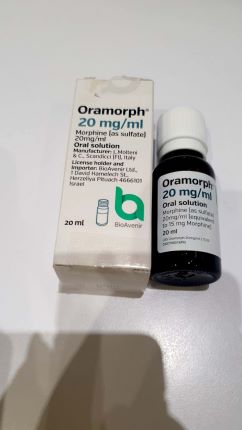Quest for the right Drug

אורמורפ 20 מ"ג / מ"ל ORAMORPH 20 MG/ML (MORPHINE AS SULFATE)
תרופה במרשם
תרופה בסל
נרקוטיקה
ציטוטוקסיקה
צורת מתן:
פומי : PER OS
צורת מינון:
תמיסה (פומי) : SOLUTION (ORAL)
עלון לרופא
מינוניםPosology התוויות
Indications תופעות לוואי
Adverse reactions התוויות נגד
Contraindications אינטראקציות
Interactions מינון יתר
Overdose הריון/הנקה
Pregnancy & Lactation אוכלוסיות מיוחדות
Special populations תכונות פרמקולוגיות
Pharmacological properties מידע רוקחי
Pharmaceutical particulars אזהרת שימוש
Special Warning עלון לרופא
Physicians Leaflet
Interactions : אינטראקציות
4.5 Interaction with other medicinal products and other forms of interaction The following interactions of this medicinal product have to be considered: Concomitant application of morphine and other medicines with centrally sedating effects such as tranquilisers, anaesthetics, hypnotics and sedatives, neuroleptics, barbiturates, tricyclic antidepressants, antihistamines / antiemetics, and other opioids or alcohol can result in an increase of the adverse effects of morphine at the usually recommended dose. This applies especially to the possibility of respiratory depression, sedation, hypotension and even coma. Sedative medicines such as benzodiazepines or related drugs The concomitant use of opioids with sedative medicines such as benzodiazepines or related drugs increases the risk of sedation, respiratory depression, coma and death because of additive CNS depressant effect. The dose and duration of concomitant use should be limited (see section 4.4). Morphine may possibly increase plasma concentrations of esmolol. Interactions have been reported in those subjects taking Oramorph and voriconazole. Interactions have been reported in those taking Oramorph and gabapentin. Both interactions suggest an increase in opioid adverse events when co-prescribed, the mechanism of which is not known. Caution should be taken where these medicines are co-prescribed. In a study involving healthy volunteers (N=12), when a 60 mg controlled-release morphine capsule was administered 2 hours prior to a 600 mg gabapentin capsule, mean gabapentin AUC increased by 44% compared to gabapentin administered without morphine. Therefore, patients should be carefully observed for signs of CNS depression, such as somnolence, and the dose of gabapentin or morphine should be reduced appropriately. Mixed agonist/antagonist opioid analgesics (e.g. buprenorphine, nalbuphine, pentazocine) should not be administered to a patient who has received a course of therapy with a pure opioid agonist analgesic. Medicines with anticholinergic effect (e. g. psychotropic drugs, antihistamines, antiemetics, drugs for the treatment of Morbus Parkinson) can enhance anticholinergic adverse effects of opioids (e. g. constipation, dry mouth or disturbances of micturition). Cimetidine and other drugs impairing liver metabolism can lead to higher morphine plasma concentrations due to the inhibition of its metabolism. Opioid analgesics including morphine may antagonise the actions of domperidone and metoclopramide on gastro-intestinal activity. Concomitant use of ritonavir should be avoided as the plasma concentration of morphine may be increased. The absorption of mexiletine may be delayed by concurrent use of morphine. Monoamine oxidise inhibitors are known to interact with narcotic analgesics producing CNS excitation or depression with hyper- or hypotensive crisis, (see section 4.3). Morphine can enhance the effect of muscle relaxants. In patients pre-treated with certain antidepressants (MAO inhibitors) within 14 days prior to initiation of opioids life-threatening interactions affecting the central nervous system, the respiratory and the circulatory function have been observed in relation to pethidine. Comparable effects related to morphine cannot be excluded. Concomitant application of rifampicin can lead to a decrease in the effect of morphine. A delayed and decreased exposure to oral P2Y12 inhibitor antiplatelet therapy has been observed in patients with acute coronary syndrome treated with morphine. This interaction may be related to reduced gastrointestinal motility and apply to other opioids. The clinical relevance is unknown, but data indicate the potential for reduced P2Y12 inhibitor efficacy in patients co- administered morphine and a P2Y12 inhibitor (see section 4.4). In patients with acute coronary syndrome, in whom morphine cannot be withheld and fast P2Y12 inhibition is deemed crucial, the use of a parenteral P2Y12 inhibitor may be considered.

מסגרת הכללה בסל
התוויות הכלולות במסגרת הסל
| התוויה | תאריך הכללה | תחום קליני | Class Effect | מצב מחלה |
|---|---|---|---|---|
| MORPHINE | ||||
| HYDROMORPHONE | ||||
| For the relief of severe pain in cancer. |
שימוש לפי פנקס קופ''ח כללית 1994
לא צוין
תאריך הכללה מקורי בסל
לא צוין
הגבלות
לא צוין
מידע נוסף
